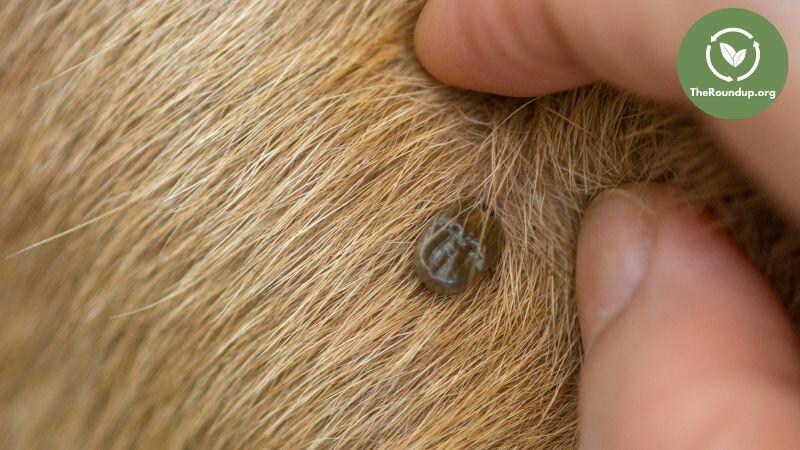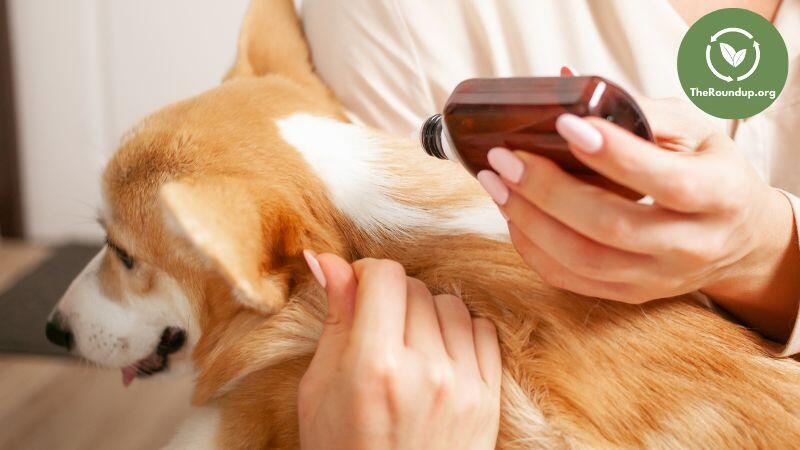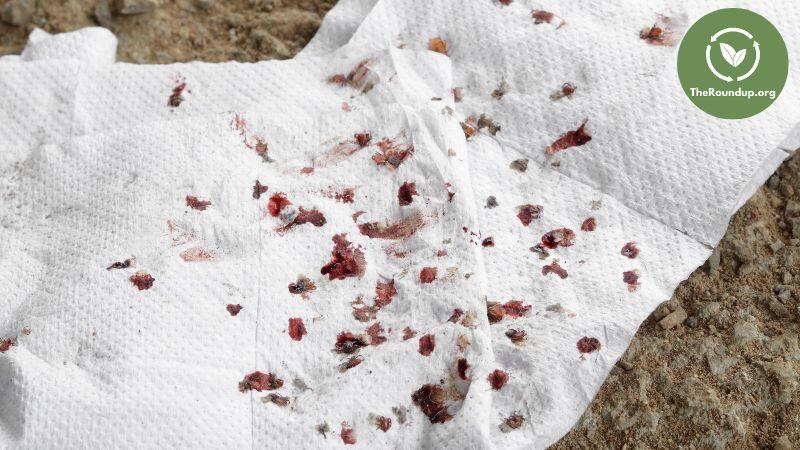
Are you struggling to deal with fleas on your beloved pets?
These tiny pests can cause a lot of discomfort and irritation to both you and your furry friends.
While many commercial products are available to combat fleas, they're often filled with harsh chemicals that may not be safe for your pets or the environment.
Luckily, there are natural home remedies that can effectively get rid of fleas and provide a safer alternative.
In this natural flea-repellent guide, I'll explore various home remedies and prevention methods to help you tackle your pest problem once and for all.
Contents

Before we dive in, let's get acquainted with our enemy.
Fleas are tiny flightless incests that think your fur baby is the best all-you-can-eat diner in town.
These parasitic pests are known for their ability to jump long distances and reproduce rapidly (a single female can lay 500 eggs in its lifetime), making them difficult to eradicate once they infest your home and pet.
There are over 2,500 species globally, with more than 300 prevalent in the US.
However, out of the myriad varieties, only four pose potential health risks to humans:
Pets can become infested in various ways.
One of the most common ways is direct contact with other infested animals. Fleas can quickly jump from one host to another, spreading the infestation.
Pets that spend time outdoors or come into contact with other animals (such as dogs in dog parks or cats roaming outside) are more susceptible to infestations.
Fleas can also be brought into your home through infested bedding, furniture, or carpets.
Awareness of the signs and symptoms of an infestation in your pet is essential. Some common signs include:
If you notice any of these signs, it's important to take immediate action to address the problem and provide relief for your pet.

Now that we've got the lay of the land let's talk tactics with a list of my favorite ways to get rid of fleas naturally.
Disclaimer: I've tried all of the remedies mentioned in the article over my decades of dog ownership, and, in my experience, they're safe and effective. While this article is specifically about dogs (my area of expertise), the remedies should be just as effective for cats. However, you use the advice mentioned in this article at your own risk. If you require further advice, please consult your veterinarian.
Apple cider vinegar is a natural and effective method to treat fleas on pets naturally.
Its beauty lies in its ability to balance a dog's pH levels, creating an environment that promotes optimal health for your furry companion while deterring pests from infesting their coat.
To prepare the solution, dilute three cups of apple cider vinegar with two cups of water and add a pinch of sea salt for enhanced efficacy.
Gently spray the mixture directly onto your dog's coat, taking care to avoid contact with their eyes.
Certain essential oils are excellent remedies for treating pets. Citronella, eucalyptus, peppermint, and rosemary have natural flea-repellent properties.
Mix three drops of your chosen essential oil with 500ml of water and spray it directly onto your pet's coat.
However, it's crucial to know that some essential oils (such as tea tree oil) can be highly toxic to pets if not appropriately diluted.
Before applying any homemade essential oil solution to your pet, please consult your veterinarian or a trusted source, such as PetMD, to confirm its safety.
This bath recipe is remarkably effective. It keeps your beloved pet smelling fresh and provides a noticeable shield against fleas.
To prepare this all-natural treatment, dilute half a cup of freshly squeezed lemon juice into two cups of water. Then, add a gentle squeeze of your regular pet-friendly soap or shampoo, ensuring that all the ingredients are well mixed.
Once prepared, you can use it as you would any pet shampoo.
A good quality pet shampoo is an excellent place to start when combating pet pests.
Look for a non-toxic pet shampoo without added chemicals to ensure your furry friend gets the gentlest treatment possible.
After lathering up your dog (the more lather and massaging, the better), let the shampoo sit and work its magic for a couple of minutes before rinsing thoroughly with warm water.
You'll be amazed how many little critters get washed away with this simple method.
Begin by brewing fresh rosemary leaves in boiling water, allowing the mixture to infuse with the herb's natural properties.
After straining the liquid, dilute it well in warm water, creating a soothing concoction that will benefit your furry friend's skin.
Once the water reaches a comfortably warm temperature, slowly pour the rosemary mixture over your dog's coat, ensuring thorough coverage.
Allow the solution to dry naturally, letting the beneficial properties of rosemary work their magic.
Neem oil, derived from the neem tree native to Burma, Sri Lanka, and parts of India, is a natural and lesser-known insect repellent with potent flea-treating properties.
You can apply it directly onto your dog's coat, add it to regular pet shampoo, or dilute it to create your own homemade spray.
By making a simple change in your dog grooming routine, you can enhance the bathing experience for your furry friend.
Instead of using your regular dog shampoo, consider using organic soap (such as peppermint or rose).
These natural alternatives not only provide effective cleansing but can also help keep pesky insects at bay.
Plus, your dog will enjoy a pleasant fragrance that will leave them smelling fresh and delightful.
Make your own for complete control over what goes into your soap!
Coconut oil, a natural and nourishing substance, is effective against infestations.
When applied directly to your dog's coat, it creates an environment that these pests detest. The best part? It's incredibly simple to use.
Rubbing a teaspoon of coconut oil into your dog's coat will enhance its shine and minimize body odor.
When introduced into your canine companion's regular diet, coconut oil can be beneficial in addressing intestinal parasites due to its potent antibacterial, antifungal, and antiviral properties.
Using a sachet is a great alternative if your dog dislikes directly applied products.
A sachet can be made in a few quick steps:
A flea comb is the OG non-toxic natural treatment.
Combing your pet's fur is an effective way to remove the pesky critters.
Use a good quality comb and thoroughly remove all existing fleas and eggs.
A homemade collar is a clever solution for maintaining continuous protection for your dog, eliminating the need for spraying or rubbing them with treatments.
Add a few drops of oil or alcohol to a cup of water and soak your dog's collar before putting it back around its neck.
If you don't want to soak the collar, you could make a temporary one from an old scarf or bandana.
My three favorite homemade collar additives are:
Lemon is an effective natural option to repel and kill fleas without causing harm to dogs and humans.
To harness its benefits, you can dip your dog's regular comb or brush into freshly squeezed lemon juice, applying it to their hair as part of their normal grooming routine.
Similarly, a cloth dipped in lemon juice can be just as effective for short-haired breeds.
Dilute vinegar or apple cider vinegar in your dog's drinking water to help combat and prevent infestations.
Conducting a taste test beforehand is advisable to ensure that your dog finds the taste palatable.
The recommended ratio is one teaspoon of vinegar for every four cups of drinking water.
This might sound a bit left field, but brewer's yeast is another way of naturally tackling the problem from the inside out.
One way to enhance your dog's overall health while preventing infestations is by incorporating a small amount of brewer's yeast into their food.
Just a half teaspoon of brewer's yeast mixed into their regular meal once a day should do the trick.
Due to the presence of carvacrol (a natural compound), oregano oil is highly effective in eliminating fleas.
Mix one teaspoon of oregano oil with three teaspoons of olive oil and apply small amounts to the areas on your pet's body where fleas typically gather (such as the ears, stomach, tail, and neck).
Use minimal quantities to avoid excessive ingestion during licking/grooming.

Dealing with an infestation in your home can be challenging, as these tiny critters can reproduce quickly.
However, you can use several natural remedies to eliminate these pests from your home.
When it comes to effective treatment, your trusty vacuum cleaner will be your best friend.
Vacuum your entire home at least once a day. Pay close attention to furniture, carpets, rugs, baseboards, and any other crevices that might be harboring fleas.
Empty the vacuum cleaner bag (or canister if your vacuum is bagless) and dispose of it in an outside bin once you're done cleaning.
By sprinkling a generous amount of baking soda directly onto your carpet, you can effectively dehydrate fleas and their eggs (and boost the effectiveness of your vacuuming).
Gently sweep the baking soda side to side with a clean broom, ensuring it penetrates the fibers.
Let the baking soda work its magic overnight.
Grab your vacuum cleaner in the morning and clean up all the baking soda (and dead bugs).
Like the baking soda method mentioned above, another effective way to combat fleas (and eggs) is by sprinkling salt on carpets and soft furnishings.
Leave the salt on overnight and vacuum the next day.
However, it is important to exercise caution when using salt. After vacuuming, ensure you properly clean out your vacuum cleaner to prevent any potential rusting caused by the salt residue.
Diatomaceous earth (an intriguing product derived from the microscopic remains of algae) is as effective with fleas as it is with getting rid of ants.
To harness its potential, sprinkle this fine powder on your carpet and allow it to rest undisturbed for two days. During this time, creating a barricade is essential to ensure neither you nor your dog inadvertently disrupts the treated area.
After 48 hours, thoroughly vacuum. This marvel of a substance works wonders by dehydrating and exterminating the eggs, effectively thwarting a potential re-infestation.
Diatomaceous earth is a very fine powder that can aggravate sensitive lungs. It's advisable to wear a mask when handling it.
Using a hot water cleaner is an effective method for eliminating pesky critters from your carpets and upholstery.
For a safer and eco-friendly approach, consider using a natural, plant-based detergent to ensure no toxic residues are left behind in your home.
Steam cleaning is another effective way to eradicate unwelcome guests from carpets and upholstery.
Start by vacuuming the infected area to remove as many fleas as possible before treating it with a hot steam cleaner.
Be cautious when operating the steam cleaner to ensure you don't overheat the fabric and cause damage.
After steam cleaning, use your vacuum again.
When you find an infestation in your house, taking immediate action is crucial.
Start by gathering all the soft furnishings your dog spends time on. Many items such as organic dog beds are machine washable, so this is going to be your quickest and most effective way to get everything clean.
Once you have everything collected, put them through a warm cycle in the washing machine to ensure that any fleas and their eggs are eliminated.
Washing all your soft furnishing and bedding is crucial, but it can be time-consuming to do regularly.
Putting everything in the tumble dryer for at least 15 minutes at a high temperature will help clean your items and kill fleas in all stages of growth (including pesky eggs, larvae, and adults).
Just be careful that the items you put in the dryer will not be damaged by the high heat.
A lemon spray is a fantastic and natural method for effective treatment without the hassle of vacuuming afterward.
To prepare the spray, boil a sliced lemon in water and allow the mixture to cool overnight, ensuring optimum infusion of lemon goodness.
In the morning, fill a spray bottle with this lemon-infused concoction and gently dampen your carpet and all soft furnishings in your home, ensuring comprehensive coverage to eradicate all the pesky critters.
A trap is an excellent way to help kill fleas inside your home without spraying chemicals.
All you need to do is fill a plate or bowl with warm water and add a few drops of your usual non-toxic dish soap, creating a mixture that acts as a high-viscosity glue.
This sticky concoction works by trapping fleas onto the surface, ensuring they cannot escape.
Leaving the trap on the floor overnight provides ample time for fleas to be drawn to it and get caught.
In the morning, dispose of the trapped bugs by emptying the mixture down the sink and thoroughly washing the plate or bowl.
Grab a pestle and mortar and whip up a batch of rosemary powder to effectively prevent any potential infestations in the future.
This all-natural flea prevention treatment can be further enhanced by adding other aromatic herbs and plants, such as refreshing peppermint, protective wormwood, fragrant fennel, and versatile rue.
These carefully selected ingredients combine to create a delicate and aromatic powder that you can evenly sprinkle throughout your home, ensuring a pleasant and flea-free environment for you and your fur baby.
A crawlspace area under your house can attract wildlife such as mice, rats, squirrels, raccoons, and birds (seeking shade in the summer and warmth in the winter).
Fleas thrive during the summer, especially in areas frequently visited by animals. These spots can become ideal breeding grounds. If your pet has access to these areas, they will likely pick an infestation from there.
Examine the vents and screens surrounding your home's foundation and roofline that serve as a barrier against wildlife.
Inspect for any corners that have been dislodged or other forms of damage or openings. Repair any damage with sections of 1/4" mesh (that can be trimmed to the appropriate size and secured using screws).
Preventing infestations in your garden or yard is another critical step in keeping your pets and home flea-free.
When inspecting your garden, consider preferred hideouts.
Fleas tend to thrive in damp and dark places, seeking refuge away from the harsh rays of sunlight. So be sure to remove any twigs, dead leaves, and excessive mulch.
Creating an environment where sunlight can freely touch every nook and cranny of your garden is crucial, so avoid overwatering and allow nature's light to work its magic.
Steinerma carpocapsea (also called Nematodes) are minuscule wonder worms you can introduce to your garden.
Not only will they coexist harmoniously with your plants, but they'll also serve as natural exterminators, ensuring the safety and comfort of your furry companions when using the yard/garden.
Sprinkling sulfur over your garden is an effective method to prevent infestations.
This natural element promotes the development of beneficial bacteria in the soil, while its anti-microbial properties will help to prevent eggs from hatching.
Sulfur should be applied to a dry garden and reapplied after every rainfall.
It's not harmful to humans but can be toxic to pets if they eat too much. So be sure to barricade off the treated areas.
The key to a flea-free garden is minimalism.
Remove any potential breeding grounds, such as old toys, furniture, and wood piles.
In addition, trim away excess leaf cover that invites fleas to hide in its shadows.
Certain plant varieties, such as spearmint, chrysanthemums, lavender, rosemary, and marigolds, possess flea-repelling properties.
Before visiting your local plant nursery, it may be prudent to research suitable plant options that thrive in your specific geographic region.
Also, be careful to avoid plants that are poisonous to pets.
Prevention is the best cure!
Once you have successfully eliminated fleas from your pets and home, it's essential to take preventive measures to keep them from returning.
Regularly grooming your pets with a comb and bathing them with a natural pet shampoo will help prevent future infestations.
Additionally, you can create one of the natural collars mentioned earlier. This will repel fleas and keep them away from your pet's neck and body.
If home treatments and preventive measures fail to rid your pets and home of fleas, it may be necessary to enlist the help of professionals.
Pest control experts possess specialized treatments and expertise to efficiently combat fleas and prevent their recurrence.
They can administer targeted treatments for your home and offer valuable advice on long-term prevention.
If possible, prioritize companies that use non-toxic products.
Having fleas is not a pleasant experience for your dog.
They may even be mad at you for all the treatments you've put them through.
Buy back their love with a bit of bribery and treat them to one (or all) of the following:
Although fleas primarily trouble pets, they can also bite humans. However, it's worth noting that fleas do not infest human hair. They instead have a preference for the luscious fur of animals.
Natural home treatments can effectively control and prevent fleas, but they may require more frequent application and diligence than commercial flea treatments. Also, the effectiveness may vary depending on the severity of the infestation.
Fleas typically hide around the ears, stomach, tail, and neck of cats and dogs. However, checking your pet's entire body for fleas is essential, as they can be challenging to spot.
It's important to check your pet regularly, especially if they spend time outdoors. Every two weeks or so is a good rule of thumb for regular inspections, but you may want to check more frequently if you notice any signs of an infestation. If fleas are found, starting treatment to get rid of fleas on dogs (and cats) as soon as possible is important.
Vinegar is an effective home remedy as it's believed to create an environment that fleas don't like.
Many chemicals-based products are available that can kill infestations quickly, such as spot-on treatments and shampoos. Be sure to read the instructions carefully before using any product on your pet.
I've never used Natural Care, but my research points to it being a safe product to use. However, I recommend trying some of the treatments listed in this article before reaching for commercial products.
Feeding dogs garlic is a contentious issue. Some believe it's good for dogs, while others claim it's poisonous. I'm on the side of this video that states garlic can be toxic to dogs and does not prevent fleas.
Dealing with fleas on your pets can be a frustrating and challenging task.
However, with the help of natural home remedies and preventive measures, you can effectively kill fleas in your home and provide relief for your pets.
By using these natural approaches, you can protect your pets and the environment from harsh chemicals while gaining control over the flea problem.
Remember to consult with your veterinarian for guidance if you're even in doubt to ensure the safety and well-being of your beloved pets.
Fleas may be tough, but you and your pet are tougher...GO GET 'EM! 💪
How do you treat a flea infestation? Do you have any natural flea control tips to add to the list? Drop me a line and let me know.

